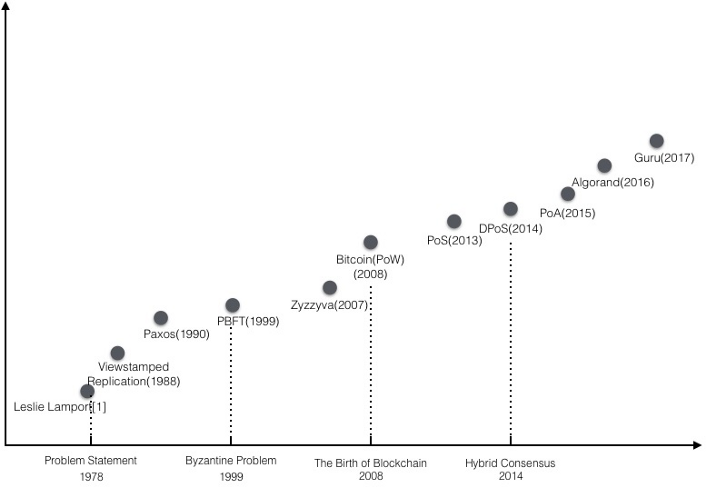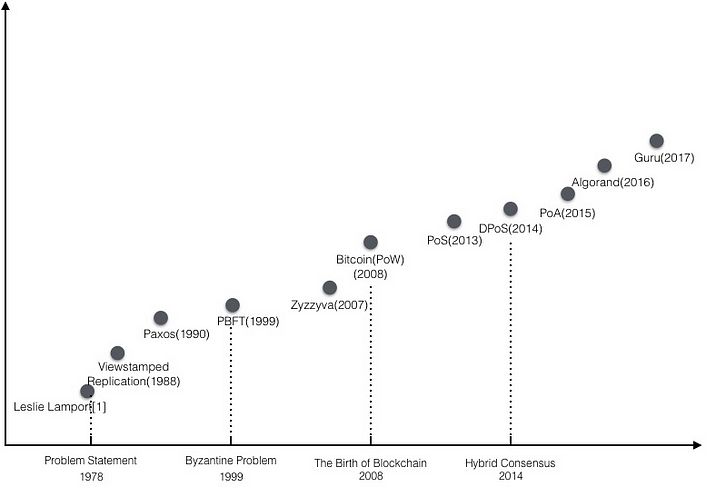Consensus Evolution
by CPChain at Sept. 5, 2018


Blockchain technology offers the benefits of security, immutability, traceability, and cost-effectiveness. This makes the blockchain perfect for use in a variety of innovative fields, including smart transportation, smart healthcare solutions, intelligent manufacturing, and smart city development. In contrast to the centralized nature of traditional distributed systems, the blockchain is an open and decentralized database maintained by all nodes that participate in the network. Establishing a public fundamental data platform using blockchain can create a trustless environment while efficiently reducing system construction costs. The consensus protocol is an absolutely crucial aspect of blockchain technology, acting as the framework for the blockchain system. Imagine a high-performance sports car and the importance of a reliable and stable frame to support and connect the various parts of the car, allowing them to function effectively and efficiently under pressure.
The DPoR (Dynamic Proof of Reputation) protocol is the stable and reliable framework for the CPChain blockchain. This framework connects various modules including PDash, OTP protocol, node identity encapsulation, blockchain maintenance, etc. The DPoR protocol has a strong anti-attack capability and can guarantee the reliable execution of the blockchain system under extreme situations.
Consensus problems have always been an important topic of distributed systems research. Because of its impact on system efficiency, security, scalability, and engineering practicability, many distributed consensus algorithms have emerged since 1978 to solve distribution problems.

Proof of Work (PoW):
The PoW consensus protocol is the underlying consensus protocol for Bitcoin, and is also used by many other cryptocurrencies. The specific implementation method is that the nodes on the network, also known as “miners”, compete for the right to mine the next block by being the first to calculate a “hash problem”. In the block reward, the “longest chain criterion” can finally determine which blocks are currently approved by the whole network.
Advantages:
Security: The calculation of the “cryptographic puzzle” is uncertain, so no one can determine who will be the owner of the next block. This uncertainty prevents any targeted attacks. Considering that the ability for a node to solve the “hash problem” is proportionate to its available amount of computational power, this effectively prevents malicious nodes from damaging the network through Sybil attacks (an attack wherein a reputation system is subverted by forging identities in peer-to-peer networks).
Disadvantages:
Resources wasted: Solving the “hash problem” requires large amounts of computational power due to the complexity of the calculations. The competition of the nodes to be the first to complete these complex calculations directly leads to wasted computational power and electricity. According to a recent report by CBS, the electricity consumption of the Bitcoin network has exceeded the electricity consumption of entire countries like Ireland for example, as well as 159 other countries.
Transaction per Second (TPS) bottleneck: Many factors lead to the TPS bottleneck including the time it takes to solve the “hash problem”, transactions needing to be verified by 6 confirmations, and the bitcoin block rate is limited to 10 minutes/block, the maximum throughput is 7 transactions per second. The PoW consensus protocol is highly limited by its utility and cannot meet the high real-time requirement of IoT.
51% attack: In theory, a 51% attack is possible in this type of system, which means that if more than 51% of the nodes are malicious, the system will be controlled by the malicious nodes.

Proof of Stake (PoS):
The PoS consensus protocol determines miners in the network by the number of coins they hold (i.e., the validator). The process is similar to buying a lottery ticket. The more coins they hold, the higher the possibility to become a validator.
Advantages:
Practicality: The PoS protocol overcomes the issue of wasting recourses that PoW consensus protocols have. The right to mine a block is no longer dependent on computing power, but on the certificate holding capacity of the node.
Efficiency: The PoS protocol has faster transaction speed, less resource consumption, and lower hardware requirements.
Disadvantages:
Concentration risk: Since the selection is no longer based on the computing power of the node, but the holding amount of the node, the system is controlled by the major coin holders.
Lack of incentives: As the system could be controlled by the largest coin holders, there is a high possibility that the ecosystem would be controlled by only a few nodes, this tends to benefit the rich. The general public is less likely to gain from that.

Delegated Proof of Stake (DPoS):
The DPoS consensus protocol uses a reputation system and real-time voting to achieve consensus. Community members vote for representatives to secure their network. These representatives form a committee, and this committee maintains the network through internal coordination.
Advantages:
Democratization: Vote-based committee elections have made the system more democratic, the elected committees are representatives, that can effectively maintain the blockchain, and give the system more self-organizational characteristics.
Efficiency: We know that it is always easier for 20 people to form a consensus than 2000 people, so DPoS can overcome the TPS bottleneck of PoW.
Disadvantages:
Anonymity risk: As the committee is elected by voting, there is a risk of identity disclosure, and the identity information of the committee may be leaked during the election process.
Concentration of interests: Voting-based elections break the uncertainty and randomization characteristics of the original PoW-based and PoS-based protocols, and since the current voting mechanism mostly relies on the number of certificates held, it may eventually have similar problems to PoS in terms of centralized control from major holders.

Dynamic Proof of Reputation (DPoR):
The DPoR consensus protocol is a combination of three major technologies: reputation assessment model, committee election algorithm, and Byzantine Fault Tolerant Algorithm (BFT). DPoR selects nodes from a pool of reputation nodes to form a committee, and the committee maintains the main chain. The Node Reputation Value Assessment Procedure (RVAP) acts as a ruler, which measures the credibility of each reputation node. The election algorithm automatically selects multiple nodes from a large pool of eligible reputation nodes to form a committee. The internal LBFT algorithm is responsible for coordinating the work between the committee members. Thus, ensuring the normal operation of the blockchain. Compared with the existing consensus protocols, the DPoR protocol improves the system’s decentralization, democratization, anonymity and dynamics.
Comparison:
Availability: Traditional distributed algorithms, such as PBFT, use a three-phase protocol to ensure system security. The communication load is high, and the throughput and network delay are greatly affected when the number of nodes is large. On the other hand, the throughput and latency of PoW-like consensus protocols are subject to certain hard limits. DPoR confirms its identity through a certain amount of local calculation and verification on the election issue, and its execution efficiency is higher than the existing algorithm. To improve the internal consensus algorithm, DPoR designed a lightweight Byzantine fault-tolerant algorithm, which simplifies the complexity of the algorithm and has a higher output speed.
Security: Security issues are very important when designing a distributed system consensus. DPoS elects a committee by voting on a node from a list of the coin’s holders to represent them as a member of a committee. This type of election evaluation criteria is relatively simple, and malicious attacks such as canvassing may occur. DPoR is based on the reputation model to ensure the credibility of the elected nodes. DPoR system election is based on the RNodes’ reputation value and random seeds. The election algorithm will be disclosed, and any node could execute the algorithm automatically, which makes the outcome verifiable, thereby ensuring the reliability of the election process. The election result has a certain randomness, and the possibility of one node being selected is proportional to its reputation value. By designing dynamic mechanisms for adding and removing decision-making committee members, the flexibility of the algorithm is guaranteed and short-term oligopoly is avoided.
Scalability: DPoR overcomes the problem of low scalability of traditional Byzantine fault-tolerant algorithms through system layering. Nodes automatically perform local election algorithms to determine the next round of committee members, so that the entire network does not need to license new nodes through specific services. At the same time, the LBFT protocol within the committee is more flexible, and the dynamic adjustment mechanism is designed so that in the event of system downtime or a malicious attack on the committee members, the committee members can ensure the availability and security of the network through network-wide supervision. Under the conditions of increasing scale, transaction volume and communication frequency, the system can work cohesively to support the normal operation.
In conclusion, DPoR focuses on the incentives, efficiency and security of the system, while overcoming the TPS bottleneck problem of the current blockchain system and protecting the nodes’ privacy and the system’s stability. The CPChain team will work on increasing the efficiency and security balancing continuously in an effort to optimize the protocol.





